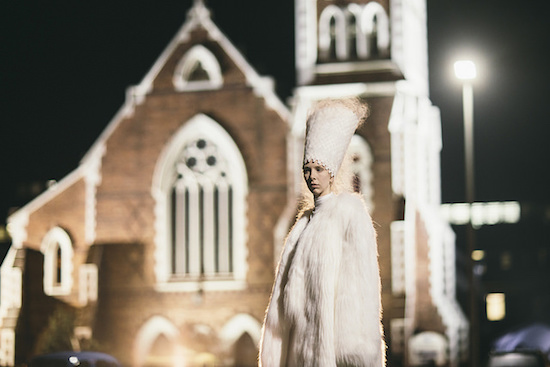photos: Dark Mofo/Lusy Productions, 2017
Mona makes it all make sense
Dark Mofo is Hobart’s two-week winter solstice festival of music and art. Its fifth year featured a city-wide sound installation, the bloody hell of Austrian artist Hermann Nitsch, a party in an operating Freemasons lodge and four raves in city hall. There was John Cage’s 4’33”, an extreme metal night, queer rappers in churches, effigy burnings and a 3am stone-smashing ritual on Bruny Island.
The festival’s mothership is the subterranean Museum of New and Old (Mona). Its permanent collection includes The Great Wall of Vagina, The Cloaca Professional “poo machine” and – for one year – the human sculpture of Tattoo Tim.
But Mona is more than the sum of its art. A visit places Dark Mofo in context. You realise that at the core of its depraved intellectualism is something far more approachable and very Australian: irreverence. A tubular glass elevator sinks you deep underground where the black – not white! – gallery walls eschew explanatory text for a headset on which a cock-and-balls icon can be pressed to consume ‘art wank’.
Dark Mofo lights up Australia’s coldest capital city with culture during what was previously hibernation season. There is a Summer festival, too, curated by Brian Ritchie of Violent Femmes. The flow-on effect of Mona and its festivals has been compared to that in Bilbao after the Guggenheim was built. Dark Mofo alone claims to inject $50 million into the Tasmanian economy and employ 1000 people. Fancy hotels, ‘locavore’ restaurants and wine bars are opening apace. Living in Hobart has changed.
Tasmania is an anagram for ‘I Am Satan’
During the festival, the local rag runs letters from outraged residents that make it sound absolutely fucking glorious to precisely its target audience. Heading to The Hope & Anchor pub with the paper for beer and oysters is a good way to spend a few non-nocturnal hours.
This year, a local named Wayne described the closing ceremonial burning as “a diabolical heathen display”. Were “followers of Dark Mofo unaware that they might be praying and worshipping and selling their souls to the devil and his darkness?” Gerry went to the Uniting Church to “have a squizz” at a performance there. He surmised this of the theremin show: “Up in the pulpit he played his no-touch thingymabob… I half expected good old Beelzebub to make a guest appearance.”
In part, you can understand the dismay of Hobart’s conservative Christians. Dark Mofo’s red cross logo is slathered across the city and Scandinavian metal bands roam the streets. At Nitsch’s 150.Action, naked, blindfolded bodies are bound to crucifixes and litres of cow blood is poured into their mouths. Experimental jazz drummer Maria Moles soundtracks 1922 witchcraft film Häxan and performance artist Mike Parr puts 70 buckets of putrid piss in a reclaimed church. Satan’s infiltration has been swift.
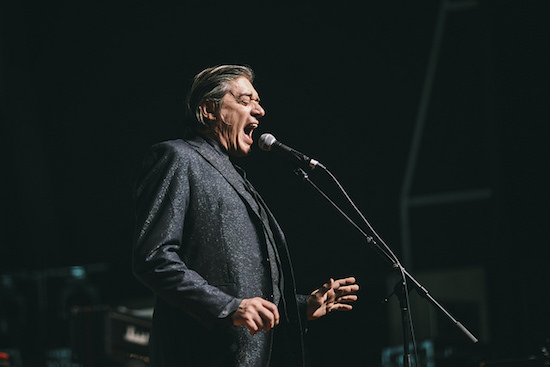
Einstürzende Neubauten blow the other bands off the stage
Apparently, Einstürzende Neubauten’s gear nearly didn’t make it down under. Another act might borrow a guitar or two and solider on. Not so Neubauten, whose motherlode of metal to clang, whack, scrape, aerate, clatter, vibrate and destroy is indispensible. Their songs are not eked from just any old bevy of dildos, hot-water tanks, dish racks and drills.
Though modifications were made. “We usually use the innards of a jet turbine for this,” says Blixa Bargeld regretfully. “But it weighs 600 kilograms.” The vibraphone they use instead features the hacked-off legs of a table from the Academy of Arts in East Berlin. We cop a great gulping eyeful of all of it because the stage is flooded with bald white light. We drink it in.
Bargeld is in a three-piece dark grey suit, shot with silver pinstripes. He’s barefoot; a disconcertingly earthy touch. They open with ‘The Garden’ – a song that builds but never breaks. You know all manner of percussive hell will erupt soon but for now, we’re left to re-acquaint with Bargeld’s mastery of poise and enunciation. The tension is sublime. When his supernatural meowing screech is let loose it eviscerates every guttural growl we heard on this stage at the metal show.
Bassist Alexander Hacke adopts a kind of legs-splayed rock-dog pose. He can do anything on that bass, from chug to funk to prowl. Meanwhile, multi-instrumentalist NU Unruh dons a funny hat to read from a scroll like a deranged town crier, sprays air onto PVC pipes during ‘How Did I Die?’ and climbs a ladder with a garbage can full of metal tubes. A few clatter to the ground.
So many ideas collide in this moment: the serious way in which Germans nail comedy;
how easily Bargeld assumes the role of impetuous maestro when he motions impatiently to Unruh; and how the metal makes a fatal-accident clamour that could be “played” no other way. A vibrator is pressed to a cymbal and vinyl is spun on a drill into a plastic cup. All instruments take an honourable seat at the table in Neubauten’s egalitarian world of sound.
We’re treated early to the frankly quite funky ‘Haus der Lüge’ but following that, things slow down. The noir slink of ‘Unvollständigkeit’ (sung in English) is my highlight. It’s as if he crawled into the song’s disembodied world and is singing out from within. One song is a “dialogue between young Blixa and old Blixa,” he says. “Or is it old Blixa and new Blixa?” New Kate likes that a lot.
Australians crave ritual
“The fears!” says the child, face lit by flames. “They’re burning.” He’s on his Dad’s shoulders watching the Ogoh-ogoh sculpture burn. He’s about six years old and can’t remember a time when this Indonesian Hindu ritual didn’t mark the onset of Tasmania’s longest night.
About 10,000 locals parade with the Ogoh-ogoh to the art installation precinct, Dark Park, where it is burned. This year an effigy of a fearsome Tasmanian Tiger is set alight. The drumming and dance stops when it goes up. This is a silent, fiery ritual, made more poignant by the marsupial’s 80-year extinction. At least this time we watch it go.
At dawn and dusk for two weeks, the voices of Tanya Tagaq, Deborah Cheetham and Carolyn Connors resound across the city. We stand on a pier in the sweet spot and spin in slow circles. We do what people do when confronted with acousmatic sound: look for the source. But there is only sky. Then we see rows of loudspeakers mounted on the tops of buildings. A helicopter swoops in with speakers on its undercarriage; the choppy drone of its rotor blades joining the mix. “Mind control!” someone yells. There’s something uniquely invasive about a sonic occupation.
The magic of sunrise and sundown help Siren Songs become Dark Mofo’s most popular ritual. It’s like one of those soft-focus pictures of angels descending from heaven has come to life.
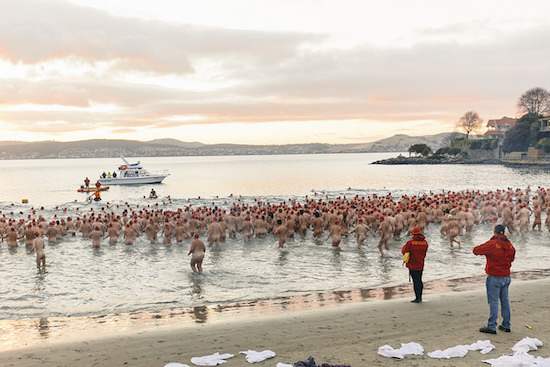
Not all of the rituals are easy
Mike Parr is known as Australia’s most extreme performance artist. A group is ferried off to Bruny Island at 1am for his latest work, Empty Ocean. By 2am we’re on the windswept island, arranged in a rectangle in a clearing lit only by a full moon. Seventy-two old people (around Parr’s age) arrive and begin to bash stones together in the dark. The occasional flinty spark is the only light. Civility frays into boredom; boredom into fatigue.
People lie prone in the prickly grass. Some stumble around the clearing like lost livestock. On and on the stones are smashed. We’re ferried home at 5am. Parr says it’s a meditation on aging and endurance, which captivates my 74-year-old mother. “Most people’s lives are repetitive and really quite uninteresting,” she says. “Like smashing stones together until you stop.”
The festival’s end is marked by a naked dawn swim in the icy River Derwent. Ritual is crucial to Dark Mofo’s programming and clearly craved by people in a country scarce on them.
Things get messy
When I venture out at 2pm after Parr’s overnight show, my hotel shows no mercy. “Our cleaners have gone home,” they say. “Can I at least get my coffee restocked?” I beg. My daily routine has been darting after maids down hallways and making demanding calls to reception. Ultimately, I dangle both the “Please service my room” and the “Do not disturb” signs on my door, figuring at least they’ll be as confused as me.
The choose-your-own adventure art party, Welcome Stranger, goes until 3am. There, I sit on a Freemason’s throne as stormy music thunders and a inflatable intestine breaths in and out before me. Earlier, dancer Amrita Hepi was here but I missed it. The party occupies eight unorthodox venues for three nights but no one knows what will happen where or when. I do see a seven-piece Thai wedding band and, later, find myself placing hot stones on a woman face down on a massage bed in a twinkling salt-encrusted gazebo.
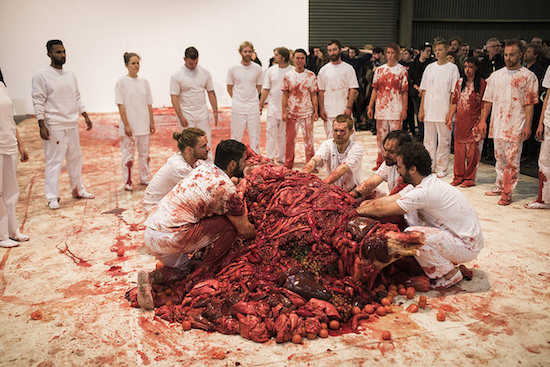
The Odeon Theatre is the stuff of dreams… and nightmares
Hobart’s double-decker Odeon Theatre puts on a cracker metal show. The lighting is precise and dramatic, the room shrouded in smoke and at one point, the red crosses behind the stage begin pin-wheeling. The festival’s legendary metal night, Hymns To The Dead, is always a treat. No hipster-metal tourists swing by: it’s stage-to-door patches, leather and manstink.
The downer warm-up act is Adelaide’s Mournful Congregation who play funeral doom without a trace of sludge; just sad repetitive riffs that sound like therapy for loss. When I pick my way to the bar, metalheads are planted equidistant from each other like mushrooms in a forest and they smell a little truffly, too. In fact, the Odeon smells like taken-off socks dipped in midwinter mildew. Barshasketh’s soulful black metal album from 2015, Ophidian Henonis, is a masterpiece of black, thrash and anthem metal with no soggy spots. Singer and guitarist Krigeist exudes metal-for-life integrity while the band’s bassist grins like a drug-fucked fool.
At other Odeon shows, however, chatty fuckers reign. The theatre’s acoustics amplify every whisper and guffaw. Though it’s the people who come to a gig to talk loudly and at length for the entire night that I want to kill. At Einstürzende Neubauten the reverence was only rent asunder once by a woman shrieking “BORING!” during ‘Silence Is Sexy’. Bargeld had raised one delicate eyebrow and extended the silence little longer. I, meanwhile, had fantasies that her neighbour elbowed her so hard she gasped for air like a hooked fish.
Some of these violent fantasies propel me through Lawrence English’s set. It is a weighty wall of bass and beauty that crushes the chatterers. In my head, they’re mown down like troops facing machine gun fire on the Western Front. Whenever his volume ascends a sense of justice prevails. When the decibels drop, the sound is stuffed full with talk. English’s music needs the lulls to recover in, so his set ends up being about three times more intense.
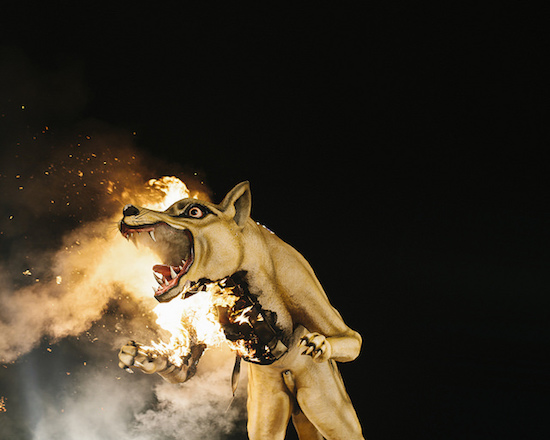
We’ll go to church if the gig’s good enough
It’s official: Australia is a nation of heathens. Our nationwide census this week confirmed that ‘no religion’ is our biggest denomination. As for church attendance? Yeah, nah. That’s halved in the last 40 years.
I go to church a lot at Dark Mofo though. And the gigs are getting progressively less holy. At midnight in Hobart’s Congregation Church I see Brisbane’s filthiest rapper, Miss Blanks, strut her filthy stuff. Coats pile up in corners as people twerk before the altar. Later, queer New York trap rapper LE1F cranks bass so loud God must hear it. He and his dancer are pure androgynous attitude – and their vogueing is glory to behold.
Meanwhile, The Crossing travels to Hobart via six smalltown Uniting Churches. Nightly, performers play in chapels with organs in various states of decrepitude. Miles Brown makes use of the Hobart church’s powerful pipe organ for a virtuosic theremin concert. Doused in fog, silhouetted in monochromatic light, all we can see is a hand coaxing soprano-like warbles from thin air. It’s Brown in a cape on his rare Moog Etherwave Pro. Silly and bombastic; it’s best church-rock gig ever.
Dark Mofo is becoming Australia’s urban Burning Man
The journey south for Dark Mofo is becoming a lot like the Burning Man pilgrimage. Both have a burning and don’t focus exclusively on feelgood vibes. In Nevada, discomfort is intensified by the hot salt plain setting. In Hobart, it’s the cold and art that’s confronting, immersive or both.
Hobart’s quaint urban setting wins out for me though. I like eating with regular Hobart families at the legendary Winter Feast. Last year the airport’s ‘Welcome to Hobart’ neon was changed to ‘Welcome to art’. This year it says ‘Once Upon A Dream’. It’s pretty surreal messaging for a capital city airport but Hobart rolls with it. Local businesses ‘go red’ in support and taller buildings look to have an inferno inside. Lots of spaces have been occupied by events in previous years so the city echoes Dark Mofos past – full of flashbacks to weird, wild times.

